
Do we begin fasting at the time of fajr or some time afterwards?
Many Muslims believe that fasting begins when it’s time for fajr prayer. However, careful analysis would prove that fasting begins some time after when fajr prayer begins.
The Quran in verse 2:187 indicates that fasting begins when “the white thread of dawn appears to you distinct from its black thread.”
| وَكُلُوا وَاشْرَبُوا حَتَّىٰ يَتَبَيَّنَ لَكُمُ الْخَيْطُ الْأَبْيَضُ مِنَ الْخَيْطِ الْأَسْوَدِ مِنَ الْفَجْرِ |
| … And eat and drink until the white thread of dawn becomes distinct to you from its black thread. …(2:187) |
In order to determine when fasting should begin, we need to understand a few concepts.
Fajr Prayer Period
Fajr is an Arabic word that means dawn. Therefore, the fajr prayer means the dawn prayer which means the fajr prayer time period is from the beginning of dawn until the end of dawn.
What is dawn?
By definition, dawn begins when the sun starts to lighten the sky and ends when the sunrise begins. Scientifically, there are 3 stages of dawn:
- Astronomical Dawn
Astronomical Dawn is when the geometric center of the Sun’s disk is 18 degrees below the horizon. At this point, twilight is so faint that it is generally indistinguishable from night, especially in areas with light pollution. - Nautical Dawn / First Light
Nautical dawn is when the geometric center of the Sun’s disk reaches an angle of 12 degrees below the horizon. The sunlight reflected by the atmosphere is now generally sufficient to distinguish the sky from land or water in clear weather conditions. This is also called “first light” because it’s the first point of dawn when the sun’s light (not the sun itself) is noticeable to the human eye. - Civil Dawn
Civil dawn is when the geometric center of the Sun’s disc is 6° below the horizon.
Sunrise
Sunrise is when the geometric center of the Sun’s disk is at the horizon.
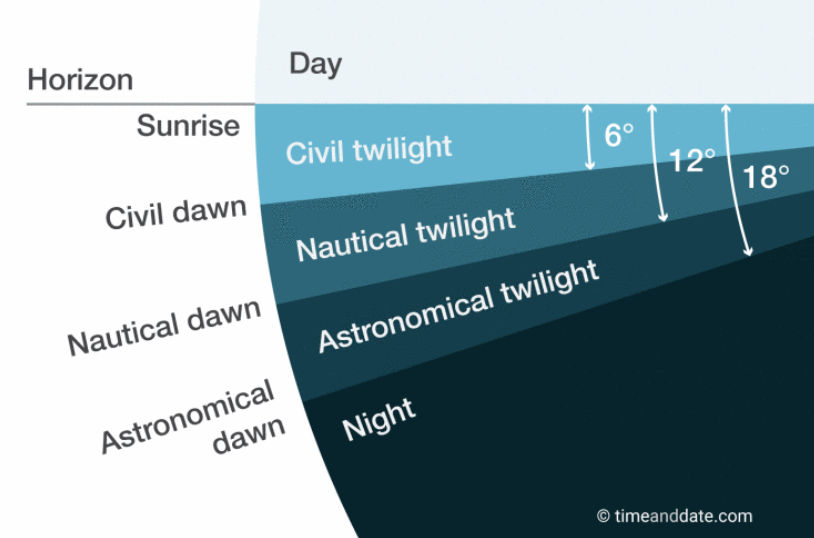
Beginning of fajr prayer time period
Muslims usually take astronomical dawn to be the beginning of the fajr prayer time period even though the sky is still dark to the human eye and light is only visible in certain conditions and possibly using scientific equipment.
Beginning of fasting
Since verse 2:187 indicates that fasting begins at the point when sunlight first becomes visible to the human eye, then based on the stages of dawn described above, the beginning of fasting would be at the beginning of the nautical dawn stage, aka “first light”.
Conclusion
Since Muslims consider the fajr prayer to begin at astronomical dawn and since we have just proven that the beginning of fasting begins at nautical dawn (first light), then fasting begins some time after the fajr prayer. In order to determine when nautical dawn or first light occurs in your area, you can visit https://www.timeanddate.com/astronomy/dawn.html
Do we end fasting at the time of maghrib (sunset) or night (layl)?
Many Muslims believe that the time to break their fast in Ramadan is at Maghrib (sunset). However, the Quran makes it very clear that you must fast till night time (layl) which is as soon as there is no more sunlight in the sky, not when the sun is setting and it’s still bright outside. This is proven in verse 2:187.
| وَكُلُوا وَاشْرَبُوا حَتَّىٰ يَتَبَيَّنَ لَكُمُ الْخَيْطُ الْأَبْيَضُ مِنَ الْخَيْطِ الْأَسْوَدِ مِنَ الْفَجْرِ ۖ ثُمَّ أَتِمُّوا الصِّيَامَ إِلَى اللَّيْلِ |
| …and eat and drink, until the white thread of dawn appears to you distinct from its black thread. Then complete the fast till the night (Arabic: layl)… (2:187) |
At no place in the Quran is ‘layl’ (night) the same thing as sunset.
What is sunset?
The description of “sunset” is clearly defined when we look at the following verse:
| حَتَّىٰ إِذَا بَلَغَ مَغْرِبَ الشَّمْسِ |
| Until, when he reached the setting of the sun (Arabic: Maghriba-l-shams) … (18:86) |
The word ‘maghriba’ comes from its root word ‘Ghurub’ (G-R-B) which means to retire, to depart, to be hidden from view or to be absent. Used along with ‘shams’ (sun) it refers to sunset, or the west which is clearly the setting place of the sun.
Verse 2:187 does not instruct people to fast until the ‘ghurub’ of the ‘shams’ (setting of the sun). Rather, it informs people to fast till ‘layl’ (night).
In verse 20:130 and 50:39, we see another reference to “ghurub” which clearly indicate the setting of the sun, aka “sunset”.
| فَاصْبِرْ عَلَىٰ مَا يَقُولُونَ وَسَبِّحْ بِحَمْدِ رَبِّكَ قَبْلَ طُلُوعِ الشَّمْسِ وَقَبْلَ غُرُوبِهَا |
| So be patient over what they say and exalt [ Allah ] with praise of your Lord before the rising of the sun and before its setting; … (20:130) |
| فَاصْبِرْ عَلَىٰ مَا يَقُولُونَ وَسَبِّحْ بِحَمْدِ رَبِّكَ قَبْلَ طُلُوعِ الشَّمْسِ وَقَبْلَ الْغُرُوبِ |
| So be patient, [O Muhammad], over what they say and exalt [ Allah ] with praise of your Lord before the rising of the sun and before its setting, (50:39) |
As you can see, the term “ghurub” which means “sunset” is well known in the Quran. If God wanted people to end their fast at sunset, He could have just used the word “ghurub” but He didn’t. Instead, God wanted people to end their fast at night which is why He used the word “layl”.
Following are some dictionary definitions of “ghurub”.

OMAR, A M, Dictionary of the Holy Quran, Arabic Words – English Meanings, Noor Foundation – International Inc, First Edition May 24, 2003, Reprint used February 26 2010, Page 400
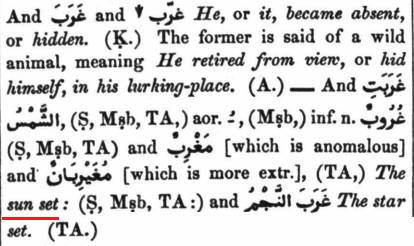
LANE. E.W, Edward Lanes Lexicon, Williams and Norgate 1863; Librairie du Liban Beirut-Lebanon 1968, Volume 3, Page 971
What is “layl” (night)
Layl (night) is when there is no more noticeable sunlight in the sky. In other words, it is when twilight has ended and the sky is dark.
In verse 91:1-4, we see that “layl” or night is when both the sun and its light can no longer be seen.
| وَالشَّمْسِ وَضُحَاهَا وَالْقَمَرِ إِذَا تَلَاهَاوَالنَّهَارِ إِذَا جَلَّاهَا وَاللَّيْلِ إِذَا يَغْشَاهَا |
| By the Sun and its brightness (splendour, brightness, brilliance – duha) and the moon when it follows it and the day (Arabic: nahar) when it displays it (sun’s glory) and the night (Arabic: layl) when it covers / conceals it. (18:86) |
If the sun is below the horizon and hidden from view but sunlight is still seen in the sky, that’s still sunset (ghurub) and not layl (night).
In verse 10:067 we see proof that daytime (nahar) is contrasted with nighttime (layl) in that daytime is when you can see things / things are visible.
| هُوَ الَّذِي جَعَلَ لَكُمُ اللَّيْلَ لِتَسْكُنُوا فِيهِ وَالنَّهَارَ مُبْصِرًا |
| It is He who made for you the night to rest therein and the day, giving sight. (18:86) |
Obviously, at sunset or maghrib time, you can still see things outside because there’s still plenty of sunlight in the sky. That’s because it isn’t nighttime (layl) yet.
Following are some verses that reference the word “layl” which clearly indicate it to mean nighttime and not sunset.
| وَهُوَ الَّذِي جَعَلَ لَكُمُ اللَّيْلَ لِبَاسًا وَالنَّوْمَ سُبَاتًا وَجَعَلَ النَّهَارَ نُشُورًا |
| And it is He who has made the night for you as clothing and sleep [a means for] rest and has made the day a resurrection. (25:47) |
| وَجَعَلْنَا بَيْنَهُمْ وَبَيْنَ الْقُرَى الَّتِي بَارَكْنَا فِيهَا قُرًى ظَاهِرَةً وَقَدَّرْنَا فِيهَا السَّيْرَ ۖ سِيرُوا فِيهَا لَيَالِيَ وَأَيَّامًا آمِنِينَ |
| And We made between them and the towns which We had blessed, towns easy to be seen, and We made stages of journey between them easy, (saying): Travel in them safely both by night (Arabic: layliya) and day. (34:18) |
| إِنَّ رَبَّكَ يَعْلَمُ أَنَّكَ تَقُومُ أَدْنَىٰ مِن ثُلُثَيِ اللَّيْلِ وَنِصْفَهُ وَثُلُثَهُ وَطَائِفَةٌ مِّنَ الَّذِينَ مَعَكَ |
| Indeed, your Lord knows, [O Muhammad], that you stand [in prayer] almost two-thirds of the night or half of it or a third of it, and [so do] a group of those with you. … (73/20) |
It would be hard to believe that the reference to the word “layl” in the above verses means sunset.
In verse 79:29, we see one more reference to “layl” which indicates that it is when there is darkness as opposed to brightness.
| وَأَغْطَشَ لَيْلَهَا وَأَخْرَجَ ضُحَاهَا |
| And He darkened its night and extracted its brightness. (79:29) |
When does layl (night) begin?
The Quran refers to certain periods of nighttime as being totally dark. For example, ‘al-layli muzliman’ (10:27) or ‘ghasaq al-layl’ (17:78). The Quran in verse 12:16 also refers to “night” as “isha” to describe the night prayer (salaat al-isha). However, the Quran doesn’t use any of these terms to describe the time at which to end fasting. Therefore, it would be reasonable to understand the beginning of night to be the end of sunset when there is no more light in the sky.
Twilight
The twilight phases in the morning are often called dawn, while the twilight phases in the evening are referred to as dusk. However, unlike the term twilight, which describes a time span, the terms dawn and dusk refer to moments during the transitions between day and night.
Civil dawn is the moment when the geometric center of the Sun is 6 degrees below the horizon in the morning. It is preceded by nautical twilight.
Similarly, civil dusk is the instant when the geometric center of the Sun is 6 degrees below the horizon in the evening. It marks the beginning of nautical twilight.
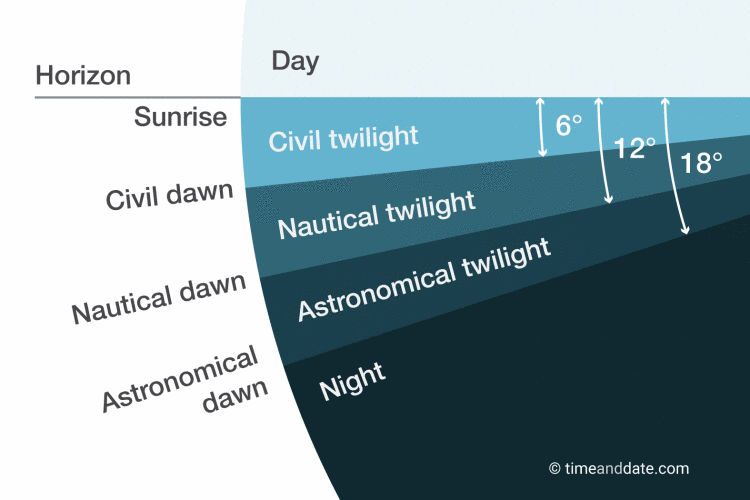
Following is an example of the different parts of a day (and night) for San Francisco on June 5, 2017.

Black is nighttime, light blue is daytime. The darker blue shadings represent the twilight phases during dawn (left) and dusk (right).
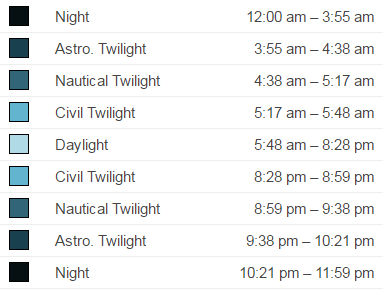
As you can see, sunset / dusk / ghurub begins at 8:28 PM. This is also the beginning of civil twilight and corresponds to the time when Muslims pray Maghrib. However, you’ll notice that when you step outside at Maghrib, there’s still plenty of sunlight in the sky. Obviously, this is not night (layl). Complete night (total darkness), in this example, begins at 10:21 PM. The beginning of night should, therefore, at least, be at the end of civil twilight which, in this example, is at 8:59 PM. According to Weather Underground (https://www.wunderground.com/), last light is at 8:59 PM. If you step outside at this time, you’ll notice that the sky is dark. Therefore, it is reasonable to take the beginning of “layl” (night) to be at the end of civil twilight.
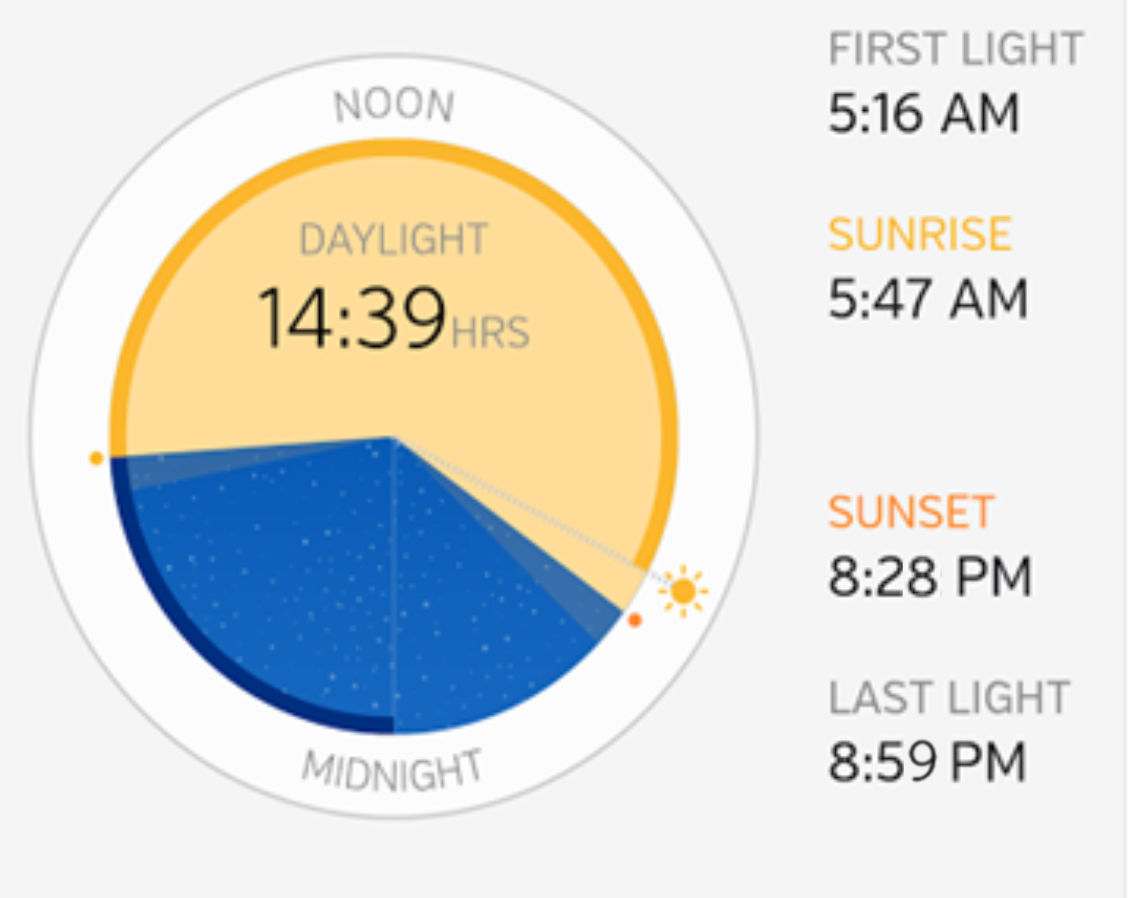
You can also use the Golden Hour app. The screenshot of Golden Hour below shows last light (beginning of night) in Hayward, CA, USA on Dec 27, 2021 to be at 5:26 PM.
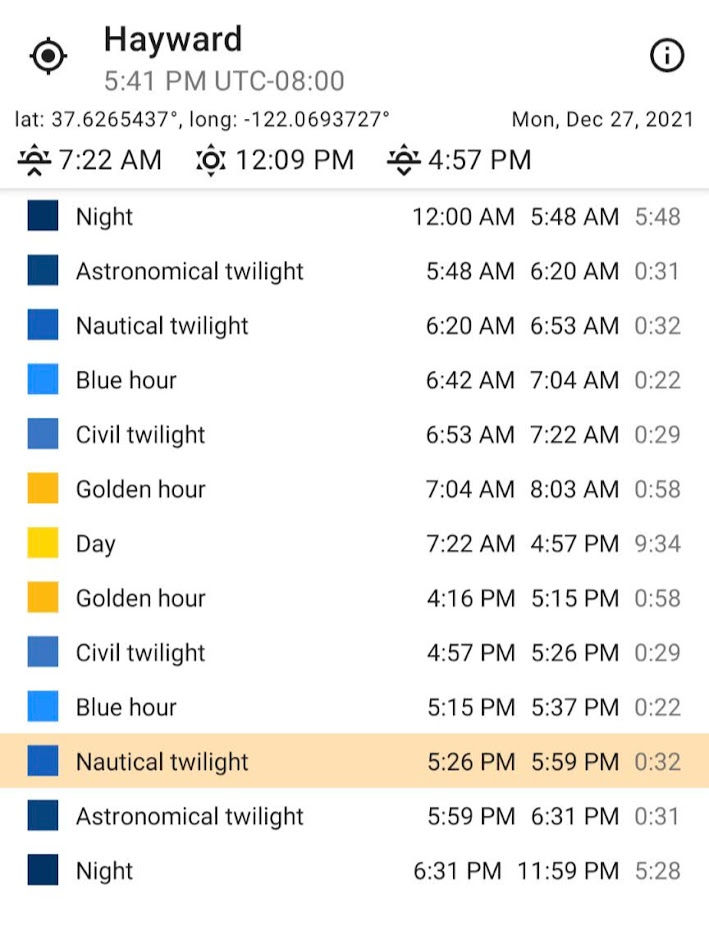
Related articles
- Proof Muslim Women Don’t Have to Cover Their Hair
- Proof the Hadith is Not Valid Islamic Law
- Muslims Are Performing the Hajj Wrong
- Muslims Are Wrong About Zakat
- Lailat Al-Qadr Is Not What You Think It Is
- Most Muslims Start & End Fasting At the Wrong Time
- Islamic Misconceptions About the Call to Prayer (Adhaan)
- Most Muslims Are Wrong About Various Aspects of Prayer
- Islamic Ablution (Wudhu) Is Simpler Than Many Muslims Think
- Muslims Don’t Need to Perform Ablution (Wudhu) Before Touching the Quran
- Deferring Matters of Islamic Law to Religious Scholars Is Not Permissible. Studying and Understanding the Quran is Required.
- Proof That the Quran Is Complete and That the Hadith Books Are Not Needed
- Prayer Among Jews, Christians, and Muslims – A Quranic Analysis
- The Testimony (Shahadah) to Convert to Islam is Inaccurate
- Categories of People According to the Quran
- Jews and Christians Are Actually Muslims
- Abraham, Not Muhammad, Was the Founder of Islam
- Jewish, Christian and Islamic Scriptures
- The Fallacy That Descendants of Prophet Muhammad Are Superior to Everyone Else
- Islamic Prophets, Messengers & Scriptures
- What is God’s Name – A Quranic Analysis
- Aliens Do Exist – A Quranic Analysis
- Most Muslims Are Asian, Not Arab
- Proof That Relatives (Wives, Children, Descendants, etc) of Islamic Prophets, Including Muhammad, Are Not Automatically Righteous
- There Is No Punishment for Blasphemy in Islam
- Proof That Arabic is Not a Holy or Superior Language
- Proof That Prophet Muhammad Is Not Exclusive or Superior to Other Prophets
- Muslims (Submitters) and Mu’mins (Believers) Are Not the Same Thing
- Most Jews, Christians, and Polytheists Are Not Infidels (Kafir)
- There Is No Quranic Proof That Zamzam Water Is Blessed Holy Water
- Muslims Are Not Allowed To Force Others To Practice Islam. So Why Do Muslims & Islamic Governments Keep Doing It?
- If You Are a Sunni or Shia Muslim, Then You’ve Violated Islamic Law
- Contrary to Extremist Belief, Muslims Are Allowed To Sing and Listen to Music
- Muslims Are Allowed To Have Statues and Photos of People in Their Homes
- Dogs Aren’t Impure. Muslims Are Allowed to Have Pet Dogs.
- Muslims Are Allowed to Pay Interest, e.g. on a Car or Home Loan
- Prophet Muhammad Was Not Illiterate. He Could Read and Write.
- Jesus is Dead & He Ain’t Comin’ Back – A Quranic Analysis
- Many Muslims Are Wrong About Getting Help From Others on the Day of Judgment
- Wills and Inheritance Law According to the Quran
- Most Muslims Are Wrong About Halal Food
- Circumcision Is Not Required Among Muslim Boys / Men
- Muslim Women Are Not Exempt From Congregational Friday Prayers
- Muslim Women Are Not Exempt From Fasting, Praying, etc During Menstruation
- The Quran Doesn’t Support a Strictly Vegetarian Diet
- Summary of the Quran
- Summary of the Quran 2
- إثبات أن الحديث ليس شرعاً إسلامياً صالحاً
- إثبات أن النساء المسلمات لسن بحاجة لتغطية شعرهم
- Bukti Hadits Tidak Valid Hukum Islam
- Kekeliruan Bahwa Keturunan Nabi Muhammad Lebih Unggul Dari Semua Orang Lain
- Bukti Wanita Muslim Tidak Harus Menutup Rambutnya Dengan Hijab



